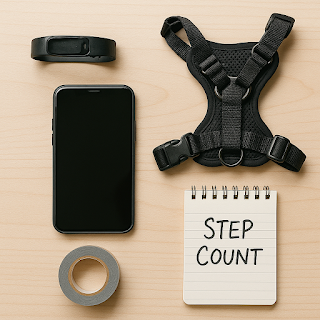Hey there, Vortex Voyagers!
Welcome back to Data & Tools Tuesday, your weekly backstage pass to the cool, geeky stuff that keeps our pets healthy and us humans just a little less clueless.
Ever peeked at your Fitbit and thought, “I wish I knew what my dog’s step count was today…”? Or maybe your cat’s 3AM parkour routine deserves some cold, hard data?
Well, tighten your leash because today, we’re diving into the world of DIY pet wearables - yes, you can track your furball’s daily zoomies without blowing your whole treat budget.
What Is Wearable Pet Data?
Wearable pet data means strapping a sensor-packed device onto your pet to monitor daily activity. Think steps, sleep cycles, playtime, restlessness, or GPS location and even vital signs.
In plain English: think of it as a fitness tracker, but for your four-legged troublemaker.
Commercial pet trackers (like FitBark, Whistle, or Tractive) monitor steps, sleep, location, and sometimes even heart rate. They can cost anywhere from $50–$300 upfront, plus a subscription.
But what if you’re a broke student (been there), a budget-savvy pet parent, or just a curious DIY nerd (guilty again)?
That’s where our inner MacGyver shines.
How Does It Work?
At its core, tracking pet activity means capturing motion and turning it into meaningful data:
- Accelerometers detect movement - the same tiny gadget in your phone that knows if it’s being shaken, tilted, or still.
- Bluetooth or Wi-Fi sends the info to your phone.
- Apps help you visualize steps, sleep, or “OMG WHERE DID HE GO NOW?!” alerts.
Commercial devices are basically tiny smartwatches for pets. But you can build a simple version using affordable human fitness trackers, Arduino kits or even old smartphones.
My Personal Story: The “Belt Clip” Experiment
Let me spill a secret: I once duct-taped my old fitness tracker to my Labrador’s harness. I called it the FrankenFit.
Guess what? It worked. Sort of.
I got some hilariously inaccurate step counts (apparently, tail wagging adds steps - science!), but it still gave me a rough idea of his daytime activity and nap times.
Did it replace proper vet checks? Nope. But did it keep me entertained and gave me useful patterns to share with my vet? Absolutely.
Why track at all?
- Monitor Health Trends: Activity dips can signal pain, arthritis, illness, or depression.
- Manage Weight: Vets often recommend daily exercise for overweight pets - trackers help quantify progress.
- Understand Behavior: Some pets are couch potatoes by day, parkour athletes by night. Data shows the truth.
- Prevent Boredom: Understimulated pets may develop destructive habits. Activity data helps spot the difference.
Basically: knowledge is power. And in the vet world, objective data + owner observations = better care.
DIY Options You Can Try
Here are three budget-friendly hacks to test the wearable waters:
1. Old Human Fitness Tracker
- Clip it securely to a well-fitted harness (never directly on a collar - choking hazard!).
- Sync to your phone like usual.
- Check daily patterns.
- Pro tip: double-check fit so your dog doesn’t eat it for breakfast.
2. Smartphone In a Pouch
- Have an old phone? Get a small pet backpack or pouch.
- Install a pedometer app or Google Fit.
- Let your pet roam, then check the app later.
- Not for heavy chewers - trust me.
3. Arduino or Raspberry Pi Pet Tracker
- For techy tinkerers: use an accelerometer sensor, a microcontroller, and basic coding.
- Plenty of tutorials online.
- This is the ultimate DIY bragging right.
What This Data Tells You (And What It Doesn’t)
✅ Useful For:
- Noticing sudden drops in activity - a red flag for pain, injury, or illness.
- Spotting unusual restlessness - stress, boredom, or hidden issues.
- Keeping track of fitness goals, especially for weight management.
What I’d Recommend as a Vet
- DIY wearables are a great conversation starter.
- If you can, invest in a pet-specific tracker for better accuracy and safe design.
- Don’t rely solely on numbers - behavior, appetite, and mood matter too.
- Keep a log and share with your vet during wellness visits.
How does the data help your Vet
As your myth-busting neighborhood vet, here’s how we use this info:
- Correlate Behavior Changes.
- Monitor Chronic Conditions.
- Guide Safe Exercise.
- Spot Early Red Flags.
Pro tip: Wearables don’t diagnose disease, they hint at patterns. A limping dog still needs an exam, not just a new gadget.
Zoonotic Implications
You know me. I never skip the zoonosis angle. Good news: Activity trackers pose zero zoonotic risk.
They don’t spread diseases or harbor germs more than any other harness or collar accessory. Just wipe them occasionally with pet-safe disinfectant.
Bottom Line
When used properly, DIY pet wearables support better outcomes by:
- Encouraging early vet visits for subtle issues
- Motivating consistent exercise for weight and heart health
- Providing proof when something’s “off” but hard to explain
In my experience, pets with engaged, observant owners tend to stay healthier and recover faster from issues - data is just one more tool to empower you.
Let’s Chat!
Have you ever tried tracking your pet’s daily adventures? Show off your DIY pet tracker in the comments! Or share your funniest “data fail” story - I promise not to judge (much).
Until next Tuesday, stay vortexy, stay nerdy, and give your pets an extra pat from me.
P.S. Want more pawsome DIY ideas? Subscribe, share, and let’s build a data-smart pet parent community together!
Check out previous post - Can Dogs See in Color? Myth vs. Reality




